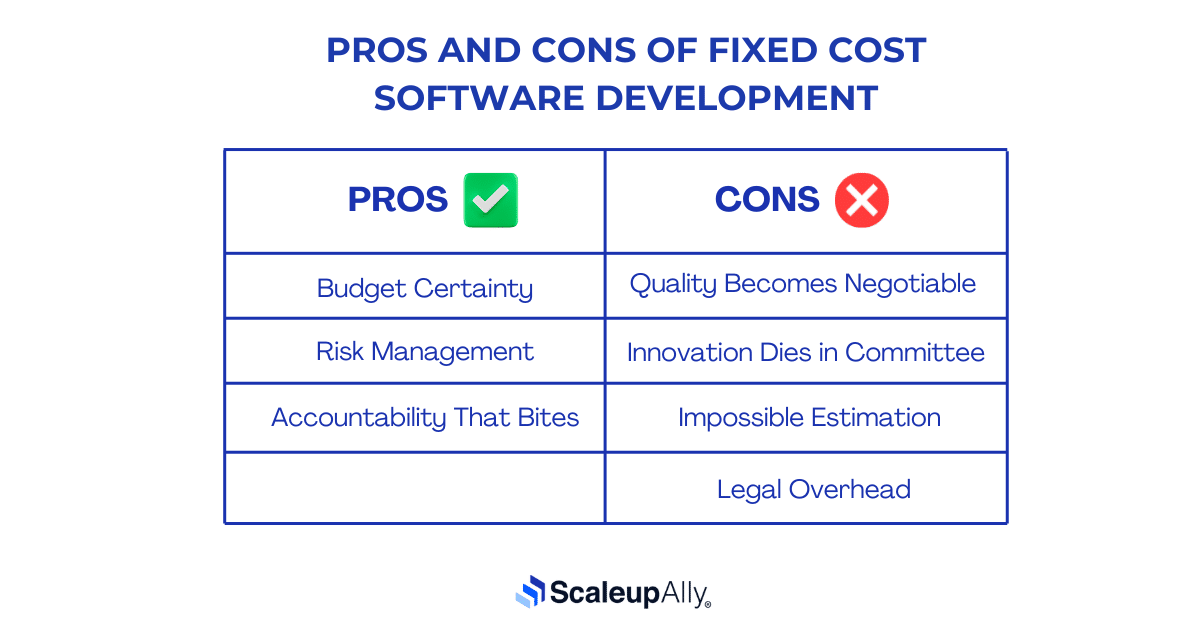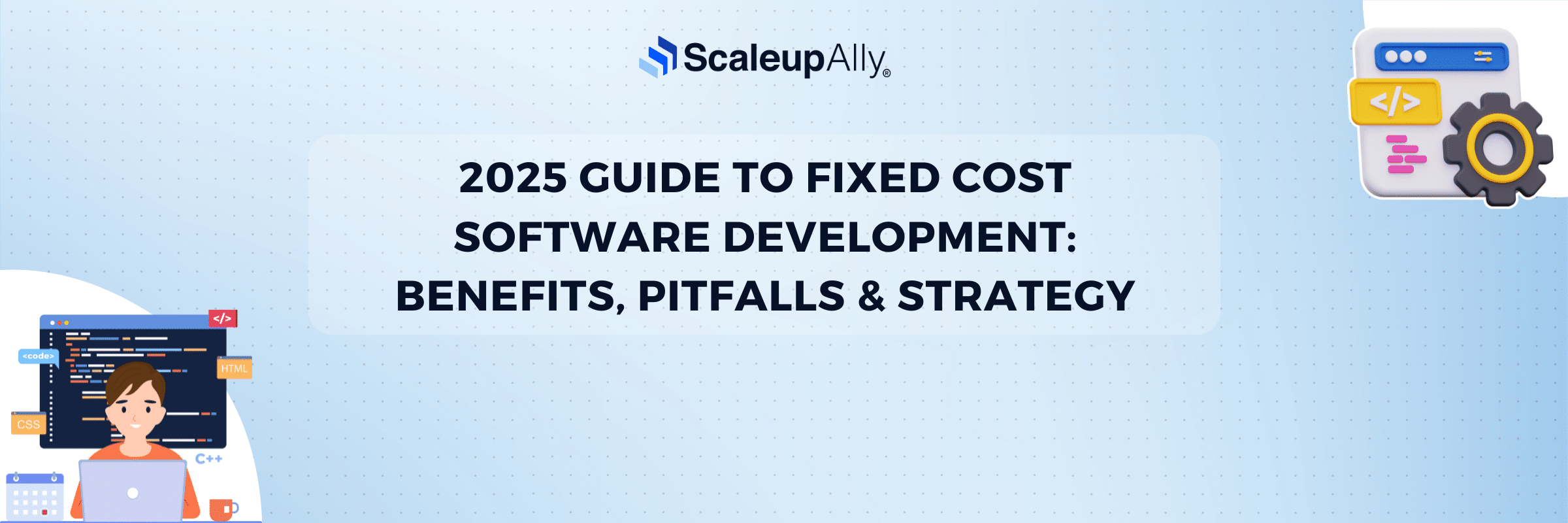
2025 Guide to Fixed Cost Software Development: Benefits, Pitfalls & Strategy
Suprabhat Sen | June 28, 2025 , 15 min read
Table Of Content
Most software projects fail because nobody wants to have the money conversation upfront. You know the dance: Stakeholders nod enthusiastically at feature lists. Developers throw around time estimates. Everyone shakes hands on a “rough budget” that somehow triples by launch day. Then comes the blame game.
Fixed cost software development changes this. Instead of crossing fingers and hoping your budget meets your expectations, you lock in a price before the first line gets written. Sounds simple, right? Not exactly.
This method can either save your project from budget hell or create an entirely different kind of nightmare. You just have to understand what you’re really buying when you pay a fixed price for custom software.
Some companies have mastered structuring deals that protect all parties while still delivering high-quality software. The ones getting burned are those making predictable mistakes.
Let’s dissect how fixed cost software development works in 2025.
Key Takeaways
- Fixed-cost software development thrives when requirements are clear. Vague or evolving scopes often lead to issues under this model. However, you’ll most likely succeed with solid specifications.
- Budget certainty comes with flexibility tradeoffs. You get locked-in costs and faster delivery, but mid-project changes become expensive.
- Quality depends on choosing the right development team. For example, experienced teams will deliver good results within your budget. But inexperienced ones will cut dangerous corners when margins get squeezed.
- Fixed pricing works well with well-defined projects with stable requirements but destroys experimental or discovery-heavy work where learning happens during development.
What is Fixed Cost Software Development?
- What is Fixed Cost Software Development?
- Why Do Businesses Choose Fixed Cost Software Development?
- When To Opt for Fixed Cost Software Development?
- Pros and Cons of Fixed Cost Software Development
- Fixed-Price vs Time and Materials Contract: Comparison
- Tips Ensuring Success with Fixed Cost Software Development
- Conclusion
- Frequently Asked Questions
Think of this like buying a house versus renting one. With fixed cost software development, you agree on a total price before construction begins, regardless of unexpected complications that arise.
Fixed cost software development means paying one predetermined amount for your entire project, whether developers encounter bugs during development or your stakeholders change their minds seventeen times, that price tag stays locked. If the development team quotes you $50,000, that’s what you pay. Not $50,000 plus overtime fees, emergency debugging charges, or those mysterious ‘complexity adjustments’ that appear in month three.
Why Do Businesses Choose Fixed Cost Software Development?
Every business owner has that moment. You’re three months into a software project, staring at an invoice that’s double your original budget, while your developer explains why the “simple” login feature requires rebuilding the entire authentication system.
Smart companies learn from these painful experiences. They start gravitating toward fixed price software development not because it’s trendy, but because it solves real problems that keep executives awake at night. Here’s why businesses are making this shift:
1. Budget Certainty Eliminates Financial Anxiety
Your accountant knows exactly what to expect. No surprise invoices, and no awkward conversations with the CFO about why development costs just jumped 40%. With fixed pricing, you can plan other business investments without wondering if your software project will devour them all. The peace of mind alone often justifies choosing fixed cost over hourly billing models.
2. Timeline Pressure Creates Laser Focus
Developers can’t drag projects out when they’re not getting paid by the hour. Suddenly, “nice to have” features get ruthlessly prioritized, and endless revision cycles disappear because time directly impacts their profit margins. This urgency often produces better software because developers focus on what matters instead of perfecting minor details. As a result, projects get shipped faster, stakeholders stay engaged, and you avoid the dreaded “development purgatory” where projects linger indefinitely without clear endpoints.
3. Risk Transfer Protects Your Investment
When something goes wrong, it’s not your problem anymore. The development team handles technical debt, integration, and third-party API changes within their fixed budget. You’re buying a finished product, not paying for someone to figure things out on your dime. This risk transfer is especially valuable for non-technical businesses who can’t accurately assess development complexity. If the project takes longer than expected, developers absorb those costs. Your business stays protected from the unpredictable nature of software development while still getting the custom solution you need.
When To Opt for Fixed Cost Software Development?
Timing matters more than most people realize. The best time to opt for fixed cost software development is:
1. Well-Defined Requirements With Minimal Unknowns
When your project scope reads like a detailed blueprint, a fixed-cost software development approach is recommended. If features have clear criteria, stories are well-defined, the database and integrations are mapped, and requirements are stable, fixed pricing works well with few surprises. Both sides know exactly what’s being built, making cost estimation reliable. When you’ve done your homework upfront, fixed pricing rewards that preparation with predictable delivery and controlled costs.
2. Proven Technology Stack Without Experimental Elements
If you’re building with established frameworks, fixed cost software development is advisable. When the team knows your tech stack, APIs are stable and well-documented, and integrations aren’t experimental, you’re in good hands. Mature tech means predictable development and fewer surprises. Developers can estimate confidently because they’ve solved similar problems before, making fixed pricing both safe and effective.
3. Tight Launch Deadlines That Cannot Move
If your product announcement is scheduled, marketing campaigns are locked in, partnership agreements depend on specific delivery dates, and when deadline flexibility doesn’t exist, fixed cost development creates the urgency needed to hit those dates. Hourly billing removes time pressure, often leading to feature creep and missed deadlines. But fixed pricing aligns everyone’s interests around shipping on time. Developers know they can’t extend timelines to increase revenue. This constraint forces difficult prioritization decisions early, resulting in focused development that meets critical business deadlines rather than drifting indefinitely.
Pros and Cons of Fixed Cost Software Development
Every pricing model has devils hiding in the details. Fixed cost software development isn’t a silver bullet that magically solves all project problems. It’s a tool (powerful when used correctly, destructive when applied blindly). Fixed pricing can save your project from budget disasters while simultaneously creating new headaches you never anticipated. Understanding both sides prevents costly mistakes and helps you make informed decisions about when this approach makes sense for your specific situation.
Pros of Fixed Cost Software Development
1. Budget Certainty
Your CFO stops asking uncomfortable questions when project costs are locked in stone. Fixed cost software development eliminates those awkward board meetings where you explain why the “simple” mobile app now costs twice the original estimate.
The peace of mind extends beyond just numbers. Product managers can focus on building great features instead of playing budget police every time someone suggests an improvement.
2. Risk Management
The development agency now owns the problem of scope creep, technical roadblocks, and unrealistic timelines. They’ve built similar systems before. They know where projects typically derail. More importantly, their profit depends on getting it right.
This works exceptionally well for companies venturing into unfamiliar technical territory. A traditional manufacturer building their first IoT platform benefits enormously when experienced developers absorb the risk of unknown complications.
3. Accountability That Bites
Nothing sharpens focus quite like payment tied to delivery. Vendors can’t bill endless hours for “research” or “optimization.” They must ship working software or forfeit profit margins.
Cons of Fixed Cost Software Development
1. Quality Becomes Negotiable
Tight margins create perverse incentives. When vendors realize they’ve underestimated complexity, corners get cut. Code reviews become cursory. Testing gets compressed. Documentation disappears.
The result? Software that technically meets requirements but collapses under real-world usage. Your savings evaporate when post-launch fixes cost more than the original development.
2. Innovation Dies in Committee
Fixed contracts reward conformity, not creativity. Development teams stick to predetermined solutions even when better approaches emerge during construction. They’re contractually obligated to build what was specified, not what should be built.
Instagram’s iconic photo filters weren’t in any original specification document. They emerged organically during development. Fixed pricing might have killed that breakthrough feature before it ever existed.
3. Impossible Estimation
Accurate fixed quotes require crystal-clear requirements. But most businesses can’t articulate detailed specifications upfront. They need to see something working before understanding what they actually want.
This creates an absurd situation: vendors quote high to cover uncertainty, making fixed pricing potentially more expensive than transparent hourly billing. Industry research suggests padded fixed quotes run 30-50% above actual development costs.
4. Legal Overhead
Fixed contracts demand extensive documentation defining every deliverable, acceptance criterion, and change process. This bureaucracy can slow development velocity and poison client-vendor relationships.
The best software emerges from collaborative partnerships. Heavy legal frameworks often work against the trust and flexibility that great products require.
Fixed-Price vs Time and Materials Contract: Comparison
Choosing between fixed-price and time & materials feels like picking between safety and flexibility. Both solve different problems, and the wrong choice can torpedo your project before it even starts.
Most businesses default to what feels safer without considering whether it fits their situation. A risk-averse CFO might demand fixed pricing for a highly experimental project, creating guaranteed failure. Meanwhile, a startup with tight cash flow might choose hourly billing and watch costs spiral beyond their runway. Here’s a comparison to help you choose:
| Feature | Fixed Price | Time & Materials |
|---|---|---|
| Budget control | Locked-in costs from day one. No surprise invoices or scope creep charges. Perfect for businesses that need predictable expenses for planning and investor relations. | Costs fluctuate based on actual work. Can spiral unexpectedly when requirements change or technical challenges emerge. Requires active budget monitoring throughout development. |
| Timeline Predictability | Developers rush to meet deadlines because delays hurt their profits. Projects typically ship faster due to built-in urgency and efficiency pressure. | Timelines can stretch indefinitely without natural pressure to finish. Developers have less incentive to avoid scope creep or feature gold-plating. |
| Payment Structure | Large upfront commitments or milestone-based payments. Better cash flow predictability for planning purposes. May require more initial capital investment. | Pay-as-you-go model spreads costs over time. Easier for startups with limited cash flow. Can pause or scale back development based on budget availability. |
| Best For | Well-defined projects with stable requirements, tight deadlines, and need for budget certainty. Ideal for established businesses with clear specifications. | Exploratory projects, evolving requirements, or situations where discovery is part of the development process. Perfect for startups and innovation projects. |
Challenges Associated with Fixed Cost Software Development
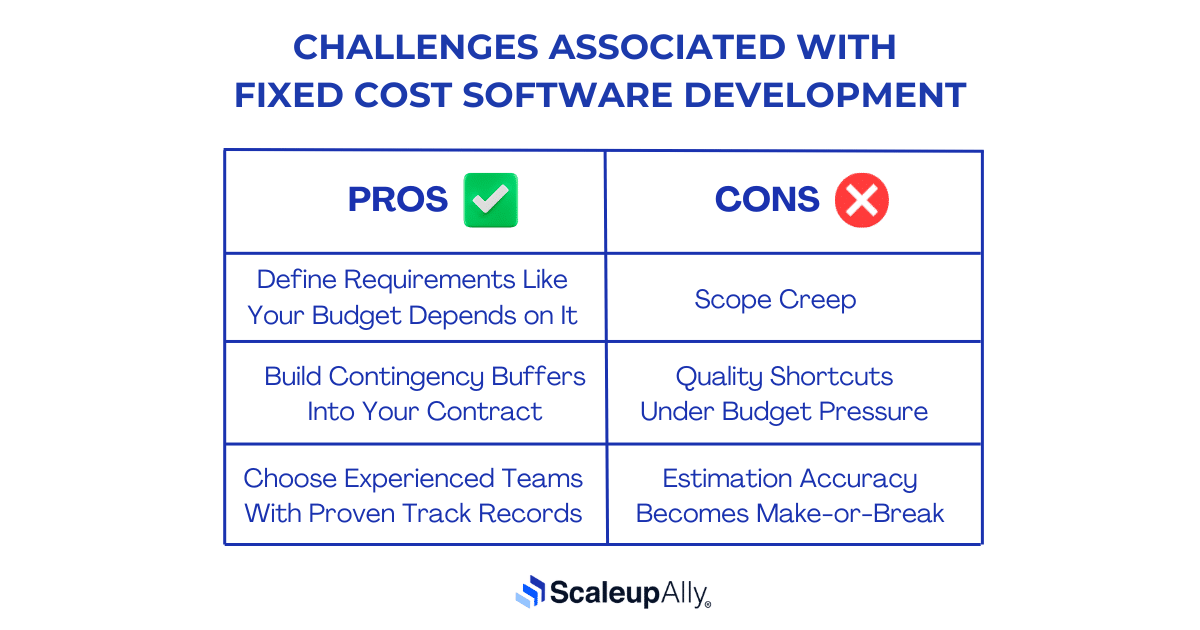
Here are some challenges associated with fixed cost software development
1. Scope Creep
Every “small addition” turns into a contract negotiation. What starts as a simple request: “Can we add a forgot password link?” becomes a formal change order process with lawyers and project managers. Teams spend more time arguing about what’s included than actually building software. The original collaborative spirit dies as both sides become defensive about scope boundaries. Developers reject reasonable requests to protect margins while clients feel held hostage by rigid contracts. This adversarial dynamic poisons working relationships and often results in software that technically meets requirements but misses the mark on user experience. Communication breaks down just when you need it most.
2. Quality Shortcuts Under Budget Pressure
When profit margins shrink, corners get cut fast. Testing becomes “good enough” instead of thorough. Code reviews get rushed. Documentation gets skipped entirely. Developers choose quick fixes over proper solutions because time directly impacts their bottom line. Security vulnerabilities slip through because comprehensive audits cost too much. Performance optimization gets postponed indefinitely. These shortcuts create ticking time bombs that explode after launch, requiring expensive emergency fixes or complete rebuilds. You might save money upfront but pay double later when systems fail under real-world usage. The pressure to deliver within budget often produces software that works initially but crumbles under pressure.
3. Estimation Accuracy Becomes Make-or-Break
One bad estimate can sink the entire project. Developers must predict complex technical challenges months in advance, but software development is inherently unpredictable. Third-party APIs change unexpectedly. Integration points prove more complex than anticipated. Platform updates break existing functionality. When estimates fall short, someone absorbs the loss. Either developers eat costs and potentially go out of business, or clients face demands for additional payments that defeat the purpose of fixed pricing. Both outcomes destroy trust and often result in unfinished projects. The need for perfect upfront estimates conflicts with the iterative, discovery-based nature of software development, creating impossible pressure on all parties involved.
Tips Ensuring Success with Fixed Cost Software Development
The following tips will ensure some success with fixed cost software development.
1. Define Requirements Like Your Budget Depends on It
Every vague requirement becomes an expensive surprise later. Write specifications that leave zero room for interpretation. Instead of “user-friendly interface,” describe exact workflows, button placements, and interaction patterns. Document every integration point, data format, and expected system behavior. Provide mockups, wireframes, and detailed user stories to enable accurate estimation. This upfront investment in clarity saves massive headaches downstream. When requirements are crystal clear, developers can’t claim features are more complex than expected, and you can’t demand functionality that wasn’t originally specified. Both sides know exactly what success looks like before anyone writes a single line of code.
2. Build Contingency Buffers Into Your Contract
Smart contracts anticipate problems before they happen. Include specific allowances for minor scope adjustments (maybe 5-10% of project value for small changes that emerge during development). Define exactly what constitutes a change order versus normal development iterations. Set clear boundaries around bug fixes, performance optimization, and third-party integration challenges. These buffers prevent every small issue from becoming a contract renegotiation. Developers feel safer bidding competitively because they know reasonable adjustments won’t destroy their margins. You get flexibility for legitimate needs without opening the floodgates to unlimited scope creep. This transforms potential conflicts into manageable discussions with predetermined solutions.
3. Choose Experienced Teams With Proven Track Records
Inexperienced developers consistently underestimate project complexity, creating disasters for everyone involved. Look for teams with multiple successful fixed-cost projects in their portfolio. Ask specific questions about how they’ve handled scope changes, technical challenges, and timeline pressures in previous projects. Review their code quality standards, testing procedures, and project management processes. Experienced teams know how to estimate accurately because they’ve been burned by unrealistic projections before. They understand which corners can be cut safely and which ones create expensive problems later. This expertise costs more upfront, but prevents the catastrophic failures that happen when inexperienced teams promise impossible deadlines or unrealistic budgets.
Conclusion
Fixed-cost software development, when used strategically, can be highly effective. When requirements are solid and teams are experienced, it delivers predictable budgets and faster timelines. When misapplied to vague projects or inexperienced developers, it creates expensive disasters.
The difference lies in honest assessment of your project’s readiness and choosing partners who’ve mastered this approach.
Ready to explore if fixed-cost development fits your next project? Contact us for a consultation today.
Frequently Asked Questions
Q: What does fixed cost mean in software development?
You pay one predetermined price for the entire project, regardless of how long development takes or what complications arise. The total cost is locked in before coding begins.
Q: How do I avoid cost overruns in a fixed cost contract?
Define requirements in meticulous detail from the outset. Include small contingency buffers for minor changes. Choose experienced developers who estimate accurately and won’t demand additional payments when challenges emerge.
Q: What types of projects are most suitable for fixed-price software development?
Projects with stable requirements, proven technology stacks, tight deadlines, and minimal unknowns. Think business applications, e-commerce sites, or mobile apps with clear functionality rather than groundbreaking innovations.
Q: Is fixed price software development suitable for custom or complex projects?
Only if complexity is well-understood beforehand. Custom projects with clear specifications work fine. Experimental or highly innovative projects with unknown variables typically fail under fixed pricing constraints.
Q: How can a fixed-price contract reduce the risk of unexpected costs?
The development team absorbs cost overruns, timeline extensions, and technical challenges. You’re protected from scope creep, integration nightmares, and complexity surprises that typically inflate budgets.
Related Blogs

Top 20 Emerging Technologies of 2026
Discover the top 20 emerging technologies of 2026. Explore which innovations are driving change across healthcare, finance, manufacturing, and other crucial industries.
ScaleupAlly Team
Dec 16 ,
9 min read
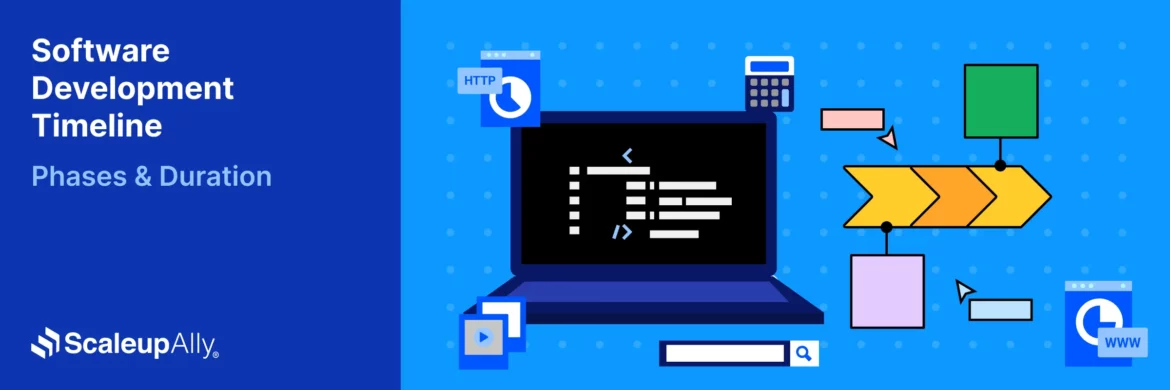
Software Development Timeline: Phases, Duration & Estimation Guide
Understand the software development timeline with phase durations, key factors, hidden delays, and practical methods to estimate project time.
Suprabhat Sen
Nov 29 ,
16 min read
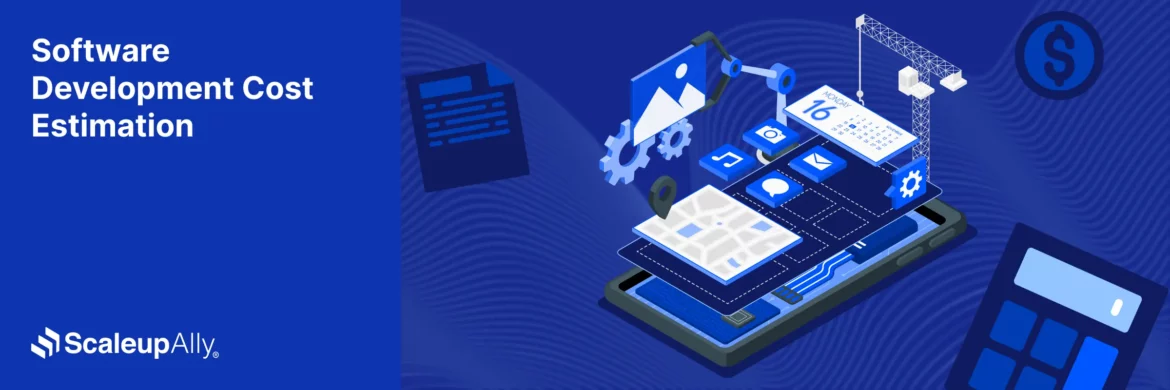
Software Development Cost Estimation Guide: What’s Included & What Affects the Price
Explore software development cost components, major pricing factors, and practical estimation methods to plan your project accurately from start to finish.
Suprabhat Sen
Nov 29 ,
14 min read

